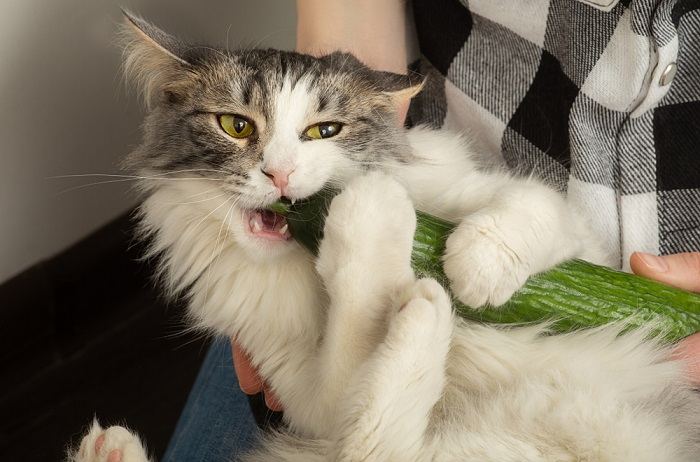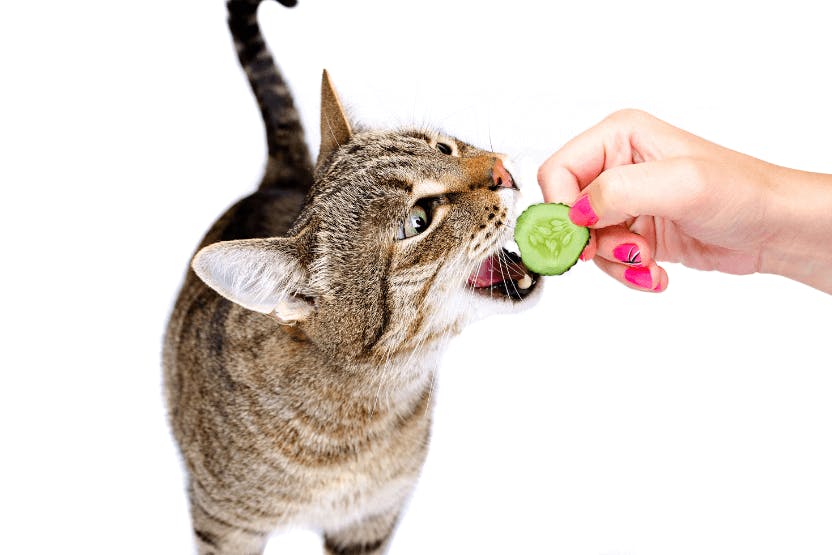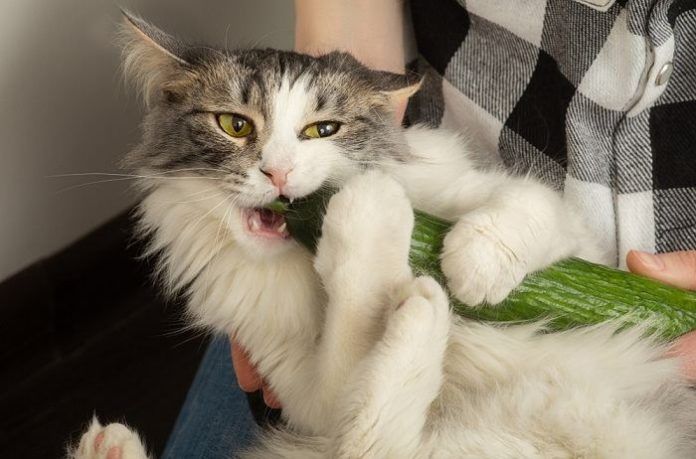Many cat owners are curious about incorporating fresh produce like cucumbers into their feline friend’s diet. However, cats have very specific nutritional requirements and digestive capabilities quite different from humans.
This article extensively explores cucumber composition, how they compare to a cat’s natural carnivorous diet, potential benefits and risks of feeding cucumbers to cats, preparation guidelines, tips for safely introducing new foods, monitoring for adverse reactions, professional warnings, and overall recommendations regarding incorporating cucumbers into feline diets.
Let’s first build foundational context around the curiosity many cat owners have surrounding cats and cucumbers.

Addressing Curiosity About Cats and Cucumbers
Seeing fresh cucumbers frequently recommended as a healthy, low-calorie snack for humans, it’s very common and natural for cat owners to wonder whether these crisp, watery vegetables are safe and nutritious for their feline companions to eat as well. However, do cucumbers properly align with cats’ specialized nutritional needs and physiology?
2. Nutritional Overview
When analyzed in depth, the nutritional composition and value of cucumbers differs significantly from the types of whole prey-based foods cats evolved over thousands of years to consume and derive nutrition from in the wild.
Cucumber Composition and Nutrients
Cucumbers are low in calories and carbohydrates and composed largely of water and fiber. They contain small amounts of vitamin K, potassium, magnesium and antioxidants. The skin of cucumbers provides additional beneficial fiber. However, cucumbers lack the protein, fatty acids, and essential amino acids cats require.
Cats’ Dietary Requirements and Variations
Unlike omnivorous humans, cats are obligate carnivores meaning they have evolved specialized digestive systems and nutritional requirements for diets high in bioavailable protein, fat, and micronutrients from animal-based ingredients. Plant matter like fruits and vegetables play only a supplemental role at most in meeting feline nutritional needs. Individual reactions and tolerances also vary considerably between cats.
3. Cats’ Natural Diet
Taking a closer look at the dietary habits and needs of felines in their natural state provides context for an appropriate nutritional profile for domesticated cats.
Carnivorous Nature of Cats
As carnivores, cats are adapted over thousands of years to acquire nutrition from hunting and consuming the meat, organs, bones, and blood of small prey animals. Their natural diet consists almost entirely of animal-based proteins and fats.
Protein and Nutrient Needs
To thrive, cats require a high bioavailable protein diet along with ample fat sources, essential amino acids like taurine only found in meat, and balanced levels of key minerals like calcium derived from consuming edible bone matter of prey.
4. Cats’ Reactions to New Foods
When it comes to their eating habits, introducing novel foods outside of cats’ usual diet warrants an incremental approach.
Typical Responses to Unfamiliar Foods
Due to their evolutionary dietary adaptations, when initially exposed to new vegetables and non-prey foods that look, smell, and taste unfamiliar, some cats may eagerly accept them, while others may sniff cautiously at first or outright reject them entirely depending on sensibilities.
Introducing New Foods Cautiously
It is important to go slowly and transition very small token amounts of any new human food like cucumbers into your cat’s regular fresh meat-based meals while carefully monitoring their individual reaction and tolerance. This minimizes potential gastrointestinal issues.
5. Cucumbers: Safe or Harmful?
When considering the various components that comprise cucumbers, are certain parts potentially problematic or toxic for cats if consumed?
Identifying Safe Parts of Cucumbers for Cats
The peeled, seeded, fleshy interior part of ripe cucumbers seems the most easily digestible and feline-friendly portion, as the skin may be too rough and fibrous, while the seeds pose a potential choking hazard or obstruction risk.
Potential Risks and Concerns
While generally low-risk, excessive consumption of cucumbers could lead to digestive upset in cats. Another consideration is the potential for exposure to pesticide residue if not thoroughly washed or from non-organic conventional cucumber sources. Choking is also a serious concern with accidental ingestion of seeds, stems or large, improperly cut chunks.
6. Benefits of Cucumbers
In very limited quantities, cucumbers may offer some potential benefits within the context of an overall nutritionally balanced feline diet.

Hydration and Fiber Content
Cucumbers are low in calories and carbohydrates and composed of roughly 96% water. This means small amounts of cucumber may supplement hydration. The skin also provides a source of fiber, which supports healthy digestion and management of hairballs.
Vitamin and Mineral Contributions
Cucumbers contain small amounts of vitamin K, vitamin C, the minerals magnesium and potassium, and antioxidants in the peels. Some nutritional variety can help round out and balance an exclusively meat-based feline diet.
7. Preparing Cucumbers for Cats
To safely minimize risks when serving cucumbers to cats, proper preparation is crucial.
Removing Skin, Seeds, and Potential Choking Hazards
The healthiest approach is to peel the tough outer skin, remove all seeds, and cut peeled cucumbers into bite-sized pieces before feeding to cats. This prevents indigestion and choking or blockage hazards.
Suitable Serving Sizes
When first introducing cucumbers, begin by offering just a few tiny, pea-sized pieces mixed into your cat’s regular food. Monitor to assess digestive tolerance before gradually increasing portion size slightly over time. Too much may upset your cat’s stomach.
8. Monitoring Cats’ Reactions
When first feeding small amounts of cucumber to your cat, stay alert for any concerning symptoms developing afterwards.
Watching for Allergies or Adverse Effects
Pay close attention and look for any signs of allergies, adverse reactions, vomiting, diarrhea, gas, lethargy or other discomfort. Stop feeding cucumbers immediately and contact your veterinarian if concerning symptoms occur.
Signs of Digestive Discomfort
Additionally monitor your cat closely for any signs of lessened appetite, constipation, increased hairball vomit, litter box difficulties, or other indicators of gastrointestinal distress in the hours or days following initial cucumber consumption.
9. Cucumber-Related Safety Measures
Take these preparatory steps to help minimize risks when considering feeding cucumber treats to cats:
Guidelines for Introducing Cucumbers
- Gradually transition small cucumber amounts over 2-3 weeks
- Feed only limited quantities and avoid free feeding
- Always monitor your cat’s individual reaction
- Ask your veterinarian in advance for preparation and serving size advice
Avoiding Overfeeding and Digestive Issues
- Feed cucumber minimally as an occasional treat to avoid disrupting your cat’s digestive health and stool consistency
- Rotate various hydrating treat options like bone broths to add nutritional diversity
10. Cats’ Individual Preferences
When it comes to matters of diet and taste, there is noticeable variability between individual cats.
Varying Tastes Among Cats
While some cats may readily accept and perceive cucumber pieces as an enjoyable treat, others may sniff cautiously at first before ultimately rejecting the unfamiliar morsels entirely. As owners, it is important we respect each cat’s personal taste preferences.
Experimenting with Different Foods
Continue exploring other low-risk fruits or vegetables in tiny amounts to identify any treat options your individual cat likes. However, always emphasize and prioritize proper animal-based proteins as the core staples of your cat’s balanced diet.
11. Foods to Avoid
Unlike these known hazardous foods, properly prepared cucumbers fed judiciously seem relatively safe for cats.
List of Toxic Foods for Cats
Be sure to completely avoid giving cats chocolate, alcohol, coffee, raw eggs, onions, grapes, raisins, macadamia nuts, xylitol or other established toxic and unsafe consumables.
Ensuring Cucumbers Are Safe in Comparison
When fed prudently in small amounts and prepared properly to avoid indigestion or choking risks, cucumbers do not appear to pose severe toxicity threats to cats as compared to definitely dangerous foods.
12. Moderation and Balanced Diet
When integrating novel treats like cucumbers into your cat’s menu, moderation and balance is key.
Incorporating Treats into a Balanced Diet
Always keep in mind that cucumbers should be treated as a supplemental human food snack, not a frequent or substantial part of your cat’s regular balanced dietary intake. Ensure your cat’s core meals provide complete and balanced nutrition.
Consulting a Veterinarian About Dietary Changes
Discuss plans to introduce any new food like cucumber pieces into your cat’s diet with your veterinarian in advance to ensure it is safe and appropriate. Follow their recommended guidelines for optimal portion size, preparation, transition schedule and monitoring.
13. Common Misconceptions
Let’s unpack and correct some common myths surrounding cats and cucumbers.
Debunking Myths About Cats and Cucumbers
Contrary to some claims, cucumbers alone cannot provide complete and balanced daily nutrition for cats. Their long-term impacts when fed regularly also require more extensive clinical study in cats.
Clarifying Nutritional Needs
While moister vegetable matter can play a supplementary role, cats have a biological need for ample animal-based proteins, fats, amino acids like taurine, and balanced calcium:phosphorus ratios only found in meat, organ and bone matter.
14. Homemade Cat Treats
For cat owners interested in homemade treats incorporating cucumber for supplemental nutrition, specialized guidance is imperative:
Recipes for Cat-Friendly Cucumber Treats
Some potential recipe ideas are baked wild salmon bites with cucumber, tuna salad seasoned with cucumber, and vitamin-enriched hydrating cucumber popsicles. Always avoid onion, garlic and other unsafe ingredients.
Ensuring Proper Nutritional Value
It is highly advisable to work closely with your veterinarian or a board-certified veterinary nutritionist to properly formulate and balance any homemade cat food recipes and treats to align with your individual cat’s dietary requirements and restrictions.
16. Summary: Cucumbers in a Cat’s Diet
In summary, while small amounts of cucumber may provide supplemental nutrition variety and hydration, effects seem to vary considerably between individual cats. Introducing cucumber requires strict feeding precautions and thorough vet monitoring for adverse reactions.
Recap of Key Points
- Cucumbers lack key feline nutrients but provide some fiber and hydration
- Feed only limited quantity as an occasional treat, not a dietary staple
- Monitor each cat’s individual reaction closely and discontinue if any intolerance
- Maximize meat-based nutrition under veterinary advice
Emphasizing Moderation and Observation
- Introduce cucumbers gradually in minimal amounts if at all
- Continually observe for adverse reactions and gastrointestinal distress
- Consult your veterinarian to inform treat decisions and portions
17. Conclusion
When it comes to making treat decisions, let science-based nutritional wisdom guide your approach.
Balancing Nutritional Value and Cat Preferences
While cats may find cucumber’s juicy crunch intriguing, ultimately emphasize appropriately balanced animal-based proteins, fats, amino acids, vitamins, and minerals to align with obligate carnivore feline physiology.
Responsible Approach to Treating Cats
Show your cat love through optimized nutrition rather than overindulging food cravings. Keep your cat’s comprehensive dietary needs and health as the priority when integrating novel treats.
18. Additional Resources
For further qualified guidance on optimizing your cat’s individual dietary and health needs:
Recommended Readings and Sources
- UC Davis: Vegetables to Feed Your Cat
- FDA: People Foods to Avoid Feeding Your Pets
- AVMA: Caring for Your Cat’s Nutritional Needs
Expert Opinions on Feline Nutrition
Schedule a consultation with your veterinarian or a board-certified veterinary nutrition specialist to develop homemade food recipes and determine appropriate incorporation of produce.

